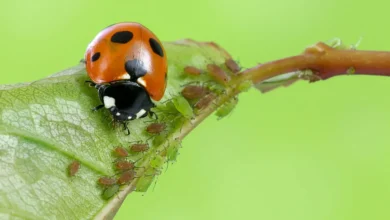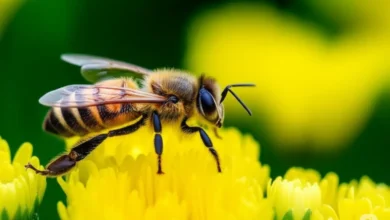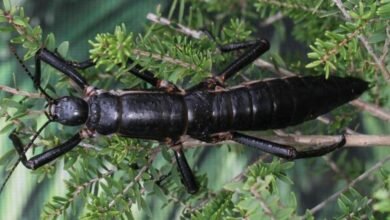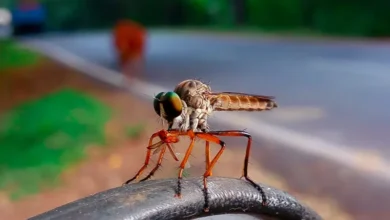In the vast web of life on Earth, few natural processes are as vital and mesmerizing as bee pollination. Though it often goes unnoticed, this fundamental interaction between bees and flowering plants fuels ecosystems, sustains biodiversity, and secures much of the food we rely on. Bees, far beyond being simple honey producers, are the champions of pollination — essential agents in maintaining plant life and agricultural productivity across the globe.
From the urban parks of Karachi to the rural fields of Sindh and beyond, bees engage in daily journeys that shape the world around us. Understanding bee pollination — how it works, who performs it, and why it matters — is key to protecting both nature and human livelihoods.
The Science Behind Bee Pollination
Pollination refers to the movement of pollen from a flower’s male structures (anthers) to its female parts (stigmas), which leads to fertilization and the production of seeds and fruit. While this can happen through wind or water, bee pollination — a type of biotic pollination — is the most effective and prevalent method, especially for flowering plants.
Two main types of pollination occur in nature:
-
Self-pollination: Pollen transfers within the same flower or plant, leading to reproduction with limited genetic diversity.
-
Cross-pollination: Pollen moves between different plants of the same species, boosting genetic variation and resilience — a task where bees excel.
Bees and flowering plants evolved together over millions of years, forming a co-dependent relationship. Flowers provide nectar and pollen; bees, in turn, perform pollination that ensures plant reproduction.
How Bee Pollination Works
Bees are anatomically and behaviorally equipped to be outstanding pollinators. Here’s how the process unfolds:
-
Attraction to Flowers: Bees are lured by colors, scents, and even invisible UV patterns. This guidance leads them to nectar-rich flowers.
-
Collecting Nectar and Pollen: While bees sip nectar using their specialized mouthparts, their fuzzy, electrostatically charged bodies pick up pollen.
-
Specialized Hairs and Pollen Baskets: Pollen sticks to their branched hairs. Some bees, like honeybees, use “pollen baskets” on their legs, while others transport it on abdominal hairs.
-
Pollen Transfer: When visiting multiple flowers, bees unintentionally deposit pollen on the sticky stigmas, enabling cross-pollination.
-
Floral Constancy: Bees often stick to one flower species per trip, increasing pollination accuracy and effectiveness.
-
Buzz Pollination (Sonication): Certain crops, like tomatoes and blueberries, require vibration to release pollen. Bumblebees excel at this technique, unlike honeybees.
Key Bee Pollinators and Their Unique Roles
Though honeybees are the most famous, over 20,000 bee species contribute to bee pollination:
-
Honeybees (Apis mellifera): Social and generalist foragers. Widely managed for pollinating crops like almonds, apples, and melons.
-
Bumblebees (Bombus spp.): Furry, robust bees that can pollinate in cold climates and perform buzz pollination — ideal for greenhouse crops.
-
Solitary Bees: These independent pollinators often specialize in certain plants and are extremely efficient.
-
Leafcutter Bees: Excellent for alfalfa and vegetable crops.
-
Mason Bees: Crucial in early spring for fruit trees like cherries and apples.
-
Mining Bees: Ground-nesters that emerge early to pollinate spring blooms.
-
Sweat Bees: Small but abundant, effective for wildflowers and crops alike.
-
This diversity in bee pollination ensures resilience and efficiency in both wild and agricultural environments.
Why Bee Pollination Matters
Ecological Importance
-
Sustaining Biodiversity: Bees pollinate around 75% of all flowering plants, maintaining ecosystems and preventing extinctions.
-
Supporting Wildlife: Many animals rely on the fruits and seeds produced through bee pollination.
-
Protecting Soil and Climate: Thriving plants support soil health and capture carbon, helping fight erosion and climate change.
Agricultural Impact
-
Boosting Crop Yields: Around one-third of our food, from apples to coffee, relies on bee pollination.
-
Enhancing Food Quality: Pollinated crops are often larger, better-shaped, and richer in nutrients.
-
Economic Contributions: Bee pollination adds hundreds of billions of dollars to the global economy annually.
-
Animal Feed and Fiber Production: Crops like clover (for livestock) and cotton also depend on bees.
Bees as Environmental Indicators
Bee populations reflect ecosystem health:
-
Pesticide Sensitivity: Bee declines can highlight harmful pesticide use.
-
Habitat Health: Low bee diversity often signals habitat destruction.
-
Climate Shifts: Changes in bee activity reveal local climate impacts.
Healthy bee communities are thus key to monitoring and protecting our environment.
The Threats and The Way Forward
Bee populations face growing risks from:
-
Habitat destruction
-
Pesticides (especially neonicotinoids)
-
Climate change
-
Parasites and diseases
To secure the future of bee pollination, we must:
-
Cultivate pollinator-friendly plants and habitats
-
Limit pesticide use
-
Support sustainable farming
-
Fund research and conservation efforts
Conclusion: Protecting the Pulse of Nature
Bee pollination is more than just a biological function — it is the lifeblood of our ecosystems and food systems. These tireless insects link the survival of wild flora with the food on our plates. By valuing the process of bee pollination, recognizing the diverse species involved, and acting to preserve them, we also protect the natural foundation of our own lives.
A future where bees thrive is a future where biodiversity, agriculture, and humanity flourish side by side. Let’s work together to ensure that the gentle hum of bees continues to echo through healthy fields, forests, and gardens across the world.




